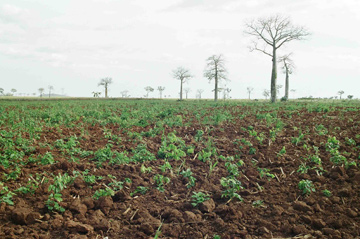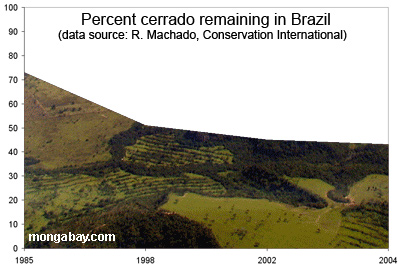Tree resprouting offers hope in former pastures of Brazil’s cerrado
Tree resprouting offers hope in former pastures of Brazil’s cerrado
Rhett A. Butler, mongabay.com
September 6, 2007
|
|
Deforested landscapes in the Brazilian cerrado show hopeful signs of recovery even after long periods of intensive use, reports a study published in the journal Biotropica.
Analyzing the natural reestablishment of native trees in former pastureland located in the dry woodlands of the Brazilian cerrado, Alexandre B. Sampaio (Universidade de Brasília), Karen D. Holl (University of California, Santa Cruz), and Aldicir Scariot (United Nations Development Programme) found that while species richness was lower in older pasture, density and composition of regenerating trees did not change with pasture age.
“The percentage of species regenerating in these ecosystems after disturbances varies between 12 and 92 percent of the original flora depending on vegetation type, land use, severity of the disturbance, and successional stage,” the authors write. “Our study suggests that density and richness of naturally regenerating seasonal deciduous forest trees in pastures of the region studied do not decrease with age up to 11-16 yr. Even very old (40 yr) pastures still have a high density and a considerable species richness of tree stems resprouting.”
 Natural regeneration of trees resprouting (all small plants on the bare soil) in an old pasture a month after plowing the soil. Photo by Alexandre Sampaio. |
The well-developed root systems of many seasonal deciduous forest species, means that trees are capable of resprouting more than decade after cutting.
“A well developed root system can also provide a strong resprouting ability in response to other anthropogenic and natural disturbances, such as fire, herbivory, and gap
formation,” they write. “Thus, tree species persisting by resprouting increase resilience of the system if the pastures are abandoned.”
Implications for forest recovery
The researchers say the findings have implications for forest recovery in parts of Brazil that have been cleared for cattle ranching.
“The results of this study have important implications for our understanding of tropical forest succession in highly disturbed lands, which comprise over 80 percent of the study region,” they write. “Our results indicate an extreme case of the initial floristic conditions model where the vast majority of species are present early in succession, due to resprouting, and appear to remain for a lengthy period of time after the abandonment of disturbed lands.”
 Biofuels driving destruction of Brazilian cerrado The cerrado, wooded grassland in Brazil that once covered an area half the size of Europe, is fast being transformed into croplands to meet rising demand for soybeans, sugarcane, and cattle. The cerrado is now disappearing more than twice as the rate as the neighboring Amazon rainforest, according to a Brazilian expert on the savanna ecosystem. |
Dr. Holl adds that the results suggest surprising resilience for the cerrado.
“Tropical scientists have long known that dry forest trees have an extensive capacity to resprout, but usually studies have focused on resprouting soon after disturbance,” she told mongabay.com. “The ability to resprout after 40 years of grazing is unprecedented in the literature and suggests a high degree of resilience in these systems.”
In a second paper, published in Restoration Ecology, the authors build on these findings and offer insight into potential habitat restoration projects in the region.
“We compared the effects of five restoration techniques, such as plowing the soil, removing grasses, adding forest litter, seeding, and planting nursery-growing seedlings, on the regeneration of seasonal deciduous forest trees in four abandoned pastures in central Brazil,” they write. “Our results suggest that early succession of seasonal deciduous forest in pastures in the region studied does not need to be stimulated once the perturbation is stopped and that intensive restoration efforts may actually slow recovery. We recommend only enrichment planting of seedlings that are not able to resprout.”
“This research clearly demonstrates the importance of understanding how an ecosystem regenerates naturally before selecting a restoration strategy,” Dr. Holl explained. “Since many species regenerate naturally in the cerrado, mechanically planting may actually damage the system more, whereas selective manual planting or seeding of species that don’t regenerate naturally can help speed recovery.”
CITATIONS: Alexandre B. Sampaio, Karen D. Holl, and Aldicir Scariot (2007). Regeneration of Seasonal Deciduous Forest Tree Species in Long-Used Pastures in Central Brazil. BIOTROPICA 39(5): 655-659 2007
Alexandre B. Sampaio, Karen D. Holl, and Aldicir Scariot (2007). Does Restoration Enhance Regeneration of Seasonal Deciduous Forests in Pastures in Central Brazil? Restoration Ecology Vol. 15, No. 3, pp. 462-471 SEPTEMBER 2007